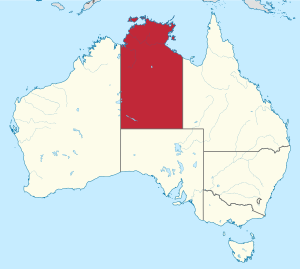
Back Noordelike Gebied Afrikaans Territorio d'o Norte AN Norþerne Landscipe ANG الإقليم الشمالي (أستراليا) Arabic لأرض دالشمال ARY نورذارن تيرريتورى ARZ Territoriu del Norte AST Şimal ərazisi (Avstraliya) Azerbaijani شومالی اوسترالیا AZB Wawengkon Kalér BAN
Northern Territory | |
|---|---|
Nickname(s):
| |
Location of Northern Territory in Australia Coordinates: 20°S 133°E / 20°S 133°E | |
| Country | Australia |
| Established by New South Wales | 1825 |
| Transferred to South Australia | 1863 |
| Transferred to Commonwealth | 1911 |
| Responsible government | 1 July 1978 |
| Capital and largest city | Darwin 12°26′17″S 130°50′28″E / 12.43806°S 130.84111°E |
| Administration | 17 local government areas |
| Demonym(s) | |
| Government | |
| Hugh Heggie | |
| Eva Lawler (ALP) | |
| Legislature | Northern Territory Legislative Assembly |
| Judiciary | Supreme Court of the Northern Territory |
| Parliament of Australia | |
• Senate | 2 senators (of 76) |
| 2 seats (of 151) | |
| Area | |
• Land | 1,347,791[3] km2 (520,385 sq mi) |
| Highest elevation | 1,531 m (5,023 ft) |
| Population | |
• December 2021 estimate | 249,345[4] (8th) |
• Density | 0.19/km2 (0.5/sq mi) (8th) |
| GSP | 2020 estimate |
• Total | AU$26.153 billion[5] (8th) |
• Per capita | AU$106,851 (2nd) |
| HDI (2021) | very high · 6th |
| Time zone | UTC+09:30 (ACST) |
| Postal abbreviation | NT |
| ISO 3166 code | AU–NT |
| Symbols | |
| Bird | Wedge-tailed eagle (Aquila audax) |
| Flower | Sturt's desert rose (Gossypium sturtianum)[7] |
| Mammal | Red kangaroo (Macropus rufus) |
| Colour(s) | Black, white, and ochre[8] |
| Website | nt |
The Northern Territory (commonly abbreviated as NT; formally the Northern Territory of Australia[9] and informally known as the Territory)[a][10] is an Australian territory in the central and central northern regions of Australia. The Northern Territory shares its borders with Western Australia to the west (129th meridian east), South Australia to the south (26th parallel south), and Queensland to the east (138th meridian east). To the north, the territory looks out to the Timor Sea, the Arafura Sea and the Gulf of Carpentaria, including Western New Guinea and other islands of the Indonesian archipelago.
The NT covers 1,347,791 square kilometres (520,385 sq mi),[citation needed] making it the third-largest Australian federal division, and the 11th-largest country subdivision in the world. It is sparsely populated, with a population of only 249,000[4] as of December 2021[update] – fewer than half as many people as in Tasmania.[4] The largest population centre is the capital city of Darwin, having about half of the territory's population. The largest inland settlement is Alice Springs with about 25,000 people.
The archaeological history of the Northern Territory may have begun more than 60,000 years ago when humans first settled this region of the Sahul Continent. From at least the 18th century, Makassan traders began a relationship with the indigenous people of the Northern Territory around the trading of trepang. The coast of the territory was first seen by Europeans in the 17th century.[11] The British were the first Europeans to attempt to settle the coastal regions. After three failed attempts to establish a settlement (1824–1828, 1838–1849, and 1864–1866), success was achieved in 1869 with the establishment of a settlement at Port Darwin.
The economy is based largely on mining and petroleum, which during 2018–2019 contributed 23% of the gross state product, or $5.68 billion, accounting for 92.4% of exports.[12][13]
The territory's population is concentrated in coastal regions and along the Stuart Highway. Besides the capital of Darwin, the major settlements are (in order of size) Palmerston, Alice Springs, Katherine, Nhulunbuy and Tennant Creek. Residents of the Northern Territory are often known simply as "Territorians" and fully as "Northern Territorians".
Cite error: There are <ref group=lower-alpha> tags or {{efn}} templates on this page, but the references will not show without a {{reflist|group=lower-alpha}} template or {{notelist}} template (see the help page).
- ^ J. Baker, Sidney (1945). The Australian Language. Angus & Robertson. p. 186. ISBN 0-908-00106-1.
- ^ "Magazine". The Canberra Times. Vol. 65, no. 20, 385. Australian Capital Territory, Australia. 3 February 1991. p. 18. Retrieved 5 September 2023 – via National Library of Australia.
- ^ "Area of Australia - States and Territories". 27 June 2014.
- ^ a b c "National, state and territory population – December 2021". Australian Bureau of Statistics. 28 June 2022. Archived from the original on 29 June 2022. Retrieved 1 July 2022.
- ^ "5220.0 – Australian National Accounts: State Accounts, 2019–20". Australian Bureau of Statistics. 20 November 2020. Retrieved 20 January 2021.
- ^ "Sub-national HDI - Area Database - Global Data Lab". hdi.globaldatalab.org. Retrieved 18 February 2023.
- ^ "Floral Emblem of the Northern Territory". Anbg.gov.auhi. Retrieved 26 March 2008.
- ^ "Northern Territory". Parliament.curriculum.edu.au. Archived from the original on 25 December 2018. Retrieved 22 January 2013.
- ^ Northern Territory Acceptance Act 1910 (Cth) s 6. "The Northern Territory is by this Act declared to be accepted by the Commonwealth as a Territory under the authority of the Commonwealth, by the name of the Northern Territory of Australia."
- ^ https://theterritory.com.au/
- ^ "Did the Spanish land in Australia before James Cook? | National Library of Australia". www.nla.gov.au. Retrieved 14 August 2020.
- ^ "Industries". Northern Territory Economy. Department of Treasury and Finance, Northern Territory Government. 2019. Retrieved 31 August 2020.
- ^ "International trade". Northern Territory Economy. Department of Treasury and Finance, Northern Territory Government. 2019. Retrieved 31 August 2020.
© MMXXIII Rich X Search. We shall prevail. All rights reserved. Rich X Search


